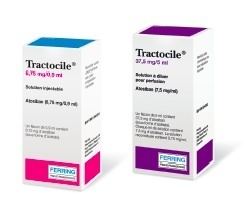Trade names Tractocile, Antocin Molar mass 994.199 g/mol | Routes ofadministration IV CAS Number 90779-69-4 CAS ID 90779-69-4 | |
 | ||
AHFS/Drugs.com International Drug Names Legal status UK: POM (Prescription only) | ||
Atosiban
Atosiban (trade names Tractocile, Antocin, Atosiban SUN) is an inhibitor of the hormones oxytocin and vasopressin. It is used as an intravenous medication as a labour repressant (tocolytic) to halt premature labor. Although initial studies suggested it could be used as a nasal spray and hence would not require hospital admission, it is not used in that form. It was developed by Ferring Pharmaceuticals in Sweden and first reported in the literature in 1985. Originally marketed by Ferring Pharmaceuticals, it is licensed in proprietary and generic forms for the delay of imminent pre-term birth in pregnant adult women.
Contents
- Atosiban
- What does atosiban mean
- Mechanism of action
- Indications
- Atosiban use after assisted reproduction
- Atosiban vs nifedipine
- Atosiban vs ritodrine
- Systematic reviews
- References
What does atosiban mean
Mechanism of action
Atosiban is a nonapeptide, desamino-oxytocin analogue, and a competitive vasopressin/oxytocin receptor antagonist (VOTra). Atosiban inhibits the oxytocin-mediated release of inositol trisphosphate from the myometrial cell membrane. As a result, there is reduced release of intracellular, stored calcium from the sarcoplasmic reticulum of myometrial cells, and reduced influx of Ca2+ from the extracellular space through voltage gated channels. In addition, atosiban suppresses oxytocin-mediated release of PGE and PGF from the decidua.
In human pre-term labour, atosiban, at the recommended dosage, antagonises uterine contractions and induces uterine quiescence. The onset of uterus relaxation following atosiban is rapid, uterine contractions being significantly reduced within 10 minutes to achieve stable uterine quiescence.
Indications
Atosiban is indicated to delay imminent pre-term birth in pregnant adult women with:
Atosiban use after assisted reproduction
Atosiban is useful in improving the pregnancy outcome of in vitro fertilization-embryo transfer (IVF-ET) in patients with repeated implantation failure (RIF). The pregnancy rate improved from zero to 43.7%.
It was seen that the first- and second-trimester bleeding was more prevalent in ART than in spontaneous pregnancies. From 2004 to 2010, 33 first-trimester pregnancies with vaginal bleeding after ART with evident uterine contractions, author used atosiban and/or ritodrine, and there was no preterm delivery before 30 weeks.
In a recent meta-analysis, nifedipine is superior to β2 adrenergic receptor agonists and magnesium sulfate for tocolysis in women with preterm labor (20–36 weeks), but it has been assigned to pregnancy category C by the Food and Drug Administration (FDA) so is not recommended before 20 weeks, or in the first trimester. Recent reports supports the use of atosiban, even at very early pregnancy, to decrease the frequency of uterine contractions to enhance success of pregnancy.
Atosiban vs. nifedipine
Recently published a retrospective study (Saleh SS. et al., 2013) comparing the efficacy and safety of atosiban and nifedipine in the suppression of pre-term labour concluded that atosiban and nifedipine are effective in delaying delivery for 7 days or more in women presenting with pre-term labour. A total of 68.3% of women in the atosiban group remained undelivered at 7 days or more, compared with 64.7% in the nifedipine group. They have the same efficacy and associated minor side-effects. However, flushing, palpitation and hypotension were significantly higher in the nifedipine group.
A clinical trial (Salim R et al., 2012) compared tocolytic efficacy and tolerability of atosiban with that of nifedipine. Forty-eight (68.6%) women allocated to atosiban and 39 (52%) to nifedipine did not deliver and did not require an alternate agent at 48 hours respectively (P=.03). Study concludes that atosiban has fewer failures within 48 hours. Nifedipine may be associated with a longer postponement of delivery.
A randomised controlled study (de Heus R. et al., 2009) demonstrated for the first time the direct effects of atosiban on fetal movement, heart rate, and blood flow. Tocolysis with either atosiban or nifedipine combined with betamethasone administration have no direct fetal adverse effects.
Atosiban vs. ritodrine
Multicentre, controlled trial of atosiban vs. ritodrine in 128 women shows a significantly better tocolytic efficacy after 7 days in the atosiban group than in the ritodrine group (60.3 versus 34.9%), but not at 48 hours (68.3 versus 58.7%). Maternal adverse events were reported less frequently in the atosiban group (7.9 vs 70.8%), resulting in fewer early drug terminations due to adverse events (0 versus 20%). Therefore, atosiban is superior to ritodrine in the treatment of preterm labour.
Systematic reviews
In a systematic review of atosiban for tocolysis in preterm labour, six clinical studies — two compared atosiban to placebo and four atosiban to a β agonist — showed a significant increase in the proportion of women undelivered by 48 hours in women receiving atosiban compared to placebo. When compared with β agonists, atosiban increased the proportion of women undelivered by 48 hours and was safer compared to β agonists. Therefore, oxytocin antagonists appear to be effective and safe for tocolysis in preterm labour.
A 2005 systematic review by the Cochrane Collaboration showed that while atosiban had fewer side effects than alternative drugs (such as ritodrine), other beta blockers, calcium channel antagonists, it was no better than placebo in the major outcomes.
